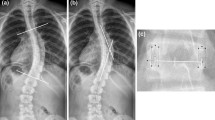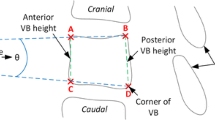Abstract
Purpose
The aim of the present research is to evaluate the relationship between an X-ray-based method (i.e. the Raimondi method) and rasterstereography in the evaluation of vertebral rotation (VR) in a sample of adolescent idiopathic scoliosis (AIS) patients.
Methods
A total of 25 patients (9 males; mean age 14 ± 3 years; mean height 160.7 ± 11.9 cm; mean weight 52.4 ± 10.7 kg) were considered for the present analysis. The mean Cobb angle was 30° ± 9°. The evaluation of VR on radiographs was made using the Raimondi method regolo (Marrapese Editore—Demi S.r.1., Rome). Rasterstereography was performed by means of Formetric 4D® (Diers International GmbH, Schlangenbad, Germany). Correlations between rasterstereographic and radiographic measurement of VR were calculated, both for the whole sample and for thoracic and lumbar spinal segments considered separately, as well as for subgroups of patients with a Cobb angle <30° and ≥30° using Spearman’s correlation coefficient by rank (r s).
Results
When applied to the entire spine, measurement of VR by means of the two methods highlighted a significant correlation in the whole group (r = 0.52; p < 0.0001), as well as in the <30° Cobb (r = 0.47; p = 0.0001) and ≥30° Cobb (r = 0.42; p < 0.0001) subgroups. A significant correlation was found also when lumbar and thoracic VR were considered as separated groups (r = 0.30, p = 0.024 and r = 0.47, p = 0.002, respectively).
Conclusions
Rasterstereographic evaluation of VR shows a good correlation with the Raimondi method, thereby confirming the possibility to use this non-invasive method for deformity assessment in AIS patients.



Similar content being viewed by others
References
Hattori T, Sakaura H, Iwasaki M, Nagamoto Y, Yoshikawa H, Sugamoto K (2011) In vivo three-dimensional segmental analysis of adolescent idiopathic scoliosis. Eur Spine J 20:1745–1750
Kuklo TR, Potter BK, Schroeder TM, O’Brien MF (2006) Comparison of manual and digital measurements in adolescent idiopathic scoliosis. Spine (Phila Pa 1976) 31:1240–1246
Stokes IA (1994) Three-dimensional terminology of spinal deformity. A report presented to the Scoliosis Research Society by the Scoliosis Research Society Working Group on 3-D terminology of spinal deformity. Spine (Phila Pa 1976) 19:236–248
Qiao J, Zhu F, Xu L, Zhu Z, Qian B, Liu Z, Qiu Y (2012) Comparison of the aorta impingement risks between thoracolumbar/lumbar curves with different convexities in adolescent idiopathic scoliosis: a computed tomography study. Eur Spine J (epub ahead of print)
Vrtovec T, Pernus F, Likar B (2009) A review of methods for quantitative evaluation of axial vertebral rotation. Eur Spine J 18:1079–1090
Cimić M, Kovac V, Smiljanić I, Kovac I, Cimić A, Smoljanović T (2009) Relationship between clinical contourometric measurements and vertebral rotation in adolescent idiopathic scoliosis. Coll Antropol 33:127–133
Kadoury S, Cheriet F, Beausejour M, Stokes IA, Parent S, Labelle H (2009) A three-dimensional retrospective analysis of the evolution of spinal instrumentation for the correction of adolescent idiopathic scoliosis. Eur Spine J 18:23–37
Pinheiro AP, Tanure MC, Oliveira AS (2010) Validity and reliability of a computer method to estimate vertebral axial rotation from digital radiographs. Eur Spine J 19:415–420
Weiss HR (1995) Measurement of vertebral rotation: Perdriolle versus Raimondi. Eur Spine J 4:34–38
Doody MM, Lonstein JE, Stovall M, Hacker DG, Luckyanov N, Land CE (2000) Breast cancer mortality after diagnostic radiography: findings from the US Scoliosis Cohort Study. Spine (Phila Pa1976) 25:2052–2056
Bone CM, Hsieh GH (2000) The risk of carcinogenesis from radiographs to pediatric orthopedic patients. J Pediatr Orthop 20:251–254
Berrington de Gonzales A, Darby S (2004) Risk of cancer from diagnostic X-rays: estimates for the UK and 14 other countries. Lancet 363:345–351
Vrtovec T, Pernus F, Likar B (2010) Determination of axial vertebral rotation in MR images: comparison of four manual and a computerized method. Eur Spine J 19:774–781
Côté P, Kreitz BG, Cassidy JD, Dzus AK, Martel J (1998) A study of the diagnostic accuracy and reliability of the Scoliometer and Adam’s forward bend test. Spine (Phila Pa 1976) 23:796–802
Easwar TR, Hong JY, Yang JH, Suh SW, Modi HN (2011) Does lateral vertebral translation correspond to Cobb angle and relate in the same way to axial vertebral rotation and rib hump index? A radiographic analysis on idiopathic scoliosis. Eur Spine J 20:1095–1105
Stokes IA, Bigalow LC, Moreland MS (1986) Measurement of axial rotation of vertebrae in scoliosis. Spine 11:213–218
Drerup B, Hierholzer E (1987) Automatic localization of anatomical landmarks on the back surface and construction of a body-fixed coordinate system. J Biomech 20:961–970
Drerup B, Hierholzer E (1992) Evaluation of frontal radiographs of scoliotic spines—Part I. Measurement of position and orientation of vertebrae and assessment of clinical shape parameters. J Biomech 25:1357–1362
Drerup B, Hierholzer E (1996) Assessment of scoliotic deformity from back shape asymmetry using an improved mathematical model. Clin Biomech 11:376–383
Hackenberg L, Hierholzer E, Pötzl W, Götze C, Liljenqvist U (2003) Rasterstereographic back shape analysis in idiopathic scoliosis after anterior correction and fusion. Clin Biomech 18:1–8
Hackenberg L, Hierholzer E, Pötzl W, Götze C, Liljenqvist U (2003) Rasterstereographic back shape analysis in idiopathic scoliosis after posterior correction and fusion. Clin Biomech 18:883–889
Schulte TL, Hierholzer E, Boerke A, Lerner T, Liljenqvist U, Bullmann V, Hackenberg L (2008) Raster stereography versus radiography in the long-term follow-up of idiopathic scoliosis. J Spinal Disord Tech 21:23–28
Huysmans T, Van Audekercke R, Vander Sloten J, Bruyninckx H, Van der Perre G (2005) A three-dimensional active shape model for the detection of anatomical landmarks on the back surface. Proc Inst Mech Eng H 219:129–142
Gorton GE 3rd, Young ML, Masso PD (2012) Accuracy, reliability and validity of a 3d scanner for assessing torso shape in idiopathic scoliosis. Spine (Phila Pa1976) 37:957–965
Hackenberg L, Hierholzer E, Bullmann V, Liljenqvist U, Götze C (2006) Rasterstereographic analysis of axial back surface rotation in standing versus forward bending posture in idiopathic scoliosis. Eur Spine J 15:1144–1149
Conflict of interest
None.
Author information
Authors and Affiliations
Corresponding author
Rights and permissions
About this article
Cite this article
Mangone, M., Raimondi, P., Paoloni, M. et al. Vertebral rotation in adolescent idiopathic scoliosis calculated by radiograph and back surface analysis-based methods: correlation between the Raimondi method and rasterstereography. Eur Spine J 22, 367–371 (2013). https://doi.org/10.1007/s00586-012-2564-9
Received:
Revised:
Accepted:
Published:
Issue Date:
DOI: https://doi.org/10.1007/s00586-012-2564-9




